Abstract
The problem of the world-class PGE-Cu-Ni Norilsk deposits’ origin has attracted geologists for several decades. The main goal of this study is to determine the specific features of ore-bearing intrusions in comparison with thousands of similar barren intrusions widespread within the Siberian igneous province, and to establish their genesis. As a result of statistical processing of previously published isotope-geochemical data and obtained by the authors, systematic differences were found in the distribution of the isotopic ratio of Nd in ore-bearing and barren intrusions, as well as in volcanic rocks at the Norilsk region. Thus, ore-bearing rocks in ten deposits (Talnakh, Kharayelakh, Norilsk 1, South-Maslovsky, North-Maslovsky, Norilsk 2, Chernogorsky, Zub-Mrksheydersky, Pyasino-Vologochansky, Imangdinsky), different in Ni and PGE reserves, show a very narrow range of Nd isotopic ratio, ԐNd(T) = 1.0 ± 1.0 (2σ, N = 139), whereas barren and volcanic rocks are characterized by a rather wide ԐNd(T) range, from −10 to +7 units (N = 256). Furthermore, ore-bearing intrusions are characterized by reduced and compact variations of the La/Lu ratio due to lower concentrations of light lanthanides. For the first time the authors studied two new intrusions penetrated by MD-48 and MD-60 boreholes drilled by Norislkgeologia LLT at the eastern part of the Mikchangda area. Their economic values are still unclear and should be estimated using geochemical methods. Both intrusions lie in the Devonian rocks, have similar thickness and mineral composition, but differ in textural and structural features, which indicate a rapid crystallization of the MD-48 intrusion. According to the contents of the major oxides, the rocks in MD-48 and MD-60 are identical, but they differ in U/Nb, La/Sm, and Gd/Yb ratios. It is important that the rocks in the MD-60 borehole are characterized by ԐNd(T) = 1.0 ± 0.6 (2σ) and fall into the range of ore-bearing intrusions, whereas the rocks in MD-48 have ԐNd(T) 2.4 ± 0.9, and, thus, are outside of ore-bearing intrusions. Therefore, ԐNd(T) values can be used as a local criterion for the estimation of economic potential of mafic intrusions, which is demonstrated for the Mikachangda area.
1. Introduction
The Norilsk district is a part of the largest PGE-Cu-Ni metallogenic province in the world [1]. This area belongs to the Siberian Traps province, which consists of igneous rocks of 250–252 Ma age [2,3]. Effusive rocks, represented by lavas and tuffs, form some formations. Intrusive rocks are divided into several groups or intrusive complexes. The Norilsk complex combines differentiated mafic-ultramafic massifs (1015 wt.% MgO) with sulfide mineralization, whose volume varies significantly from tenths of a percent upto 15% in the intrusion [4]. The high sulfide contents are typical of extra-large deposits (Oktyabr’sky, Talnakh, Norilsk 1). Identification of economically important intrusions between thousands of intrusive bodies in the area is extremely relevant.
The problem of ore formation in gabbro-dolerite massifs within the Siberian province has been under discussion for many years [4,5,6,7,8,9,10]. There are two main hypotheses regarding ore formation in closed or open magmatic systems. The latest one suggests that ore-bearing intrusions are horizontal parts of conduits for lavas to the surface [11,12,13] where sulfides are a result of the assimilation of anhydrite-containing rocks by magmas [14]. Hereby, parental magma compositions of ore-bearing intrusions and their correlations with lavas are the most substantial in the deposits’ origin. However, the relationship between ore-bearing intrusions and the lavas has yet to be proven [15] and requires more detailed consideration of their geochemical features, including the isotopic data.
We discuss the composition of the parental magmas for ore-bearing intrusions in the northwestern part of the Siberian Platform by comparing the intrusions’ compositions graduated in mineralization. We compare the well-known Talnakh and Norilsk 1 deposits in the central part of the Norilsk district (Figure 1) with numerous gabbro-dolerite intrusions in its eastern part. Due to drilling conducted by Norilskgeologiya LLC in recent years, new intrusive bodies have been discovered in the Mikchangda area. Estimating their economic value based on criteria developed for well-studied deposits is necessary. Using modern geochemical methods, the authors performed such work for two intrusions penetrated by the MD-48 and MD-60 boreholes. The results of the research are presented in this article.
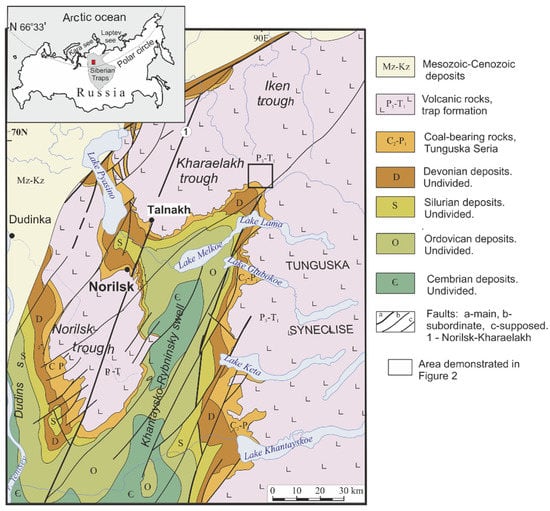
Figure 1.
Schematic geology map of the Norilsk district. 1–Norilsk-Kharaelakh fault.
2. Brief Information on the Geology of the Area
The geological structure of the Norilsk district, a part of the Siberian Platform, consists of crystalline basement and platform cover, including the Cambrian–Middle Permian sedimentary-terrigenous rocks and the Late Permian–Early Triassic volcanic rocks [16]. Intrusive bodies are genetically related to the latter ones. There are several plicative structures, i.e., Iken, Kharayelakh, and Norilsk troughs, and part of the Tunguska syneclise, separated by the Khantaysko-Rybninsky swell (KRS) (Figure 1). The main tectonic structure is the Norilsk-Kharaelakh fault.
The Mikchangda area is located at the periclinal closure of the KRS (Figure 1 and Figure 2). Mikchangdinsky and Ikensky faults and a number of smaller disturbances have been established. They divide this part of the Earth’s crust into a series of blocks raised in the area of modern river valleys (sections I-I and II-II in Figure 2b,c).
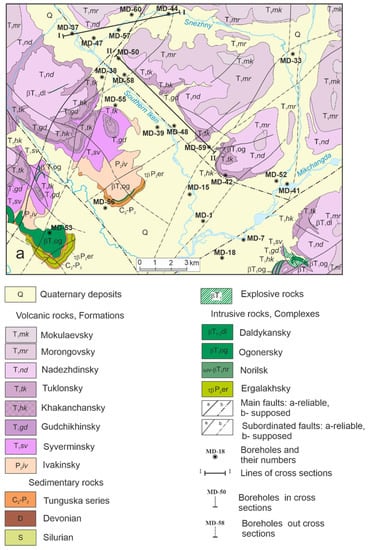
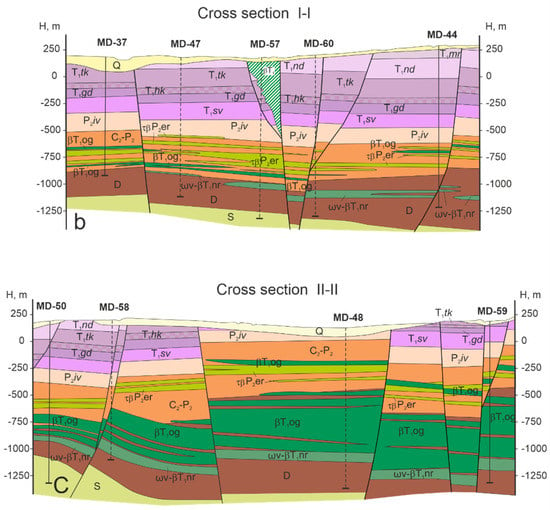
Figure 2.
Geological map of the Mikchangda area (a) and sections along the lines I-I (b) and II-II (c). Compiled by the authors based on the Norilskgeologiya LLC data (author V.N. Mikhailov), with changes.
The volcanic rocks preserve the territory’s surface, taking a subhorizontal position (Figure 2). They are subdivided into the following formations (from bottom to top): Ivakinsky, Syverminsky, Gudchikhinsky, Khakanchansky, Tuklonsky, Nadezhdinsky, Morongovsky, Mokulaevsky. The first three formations are high-Ti (TiO2 > 1.5 wt.%) and are represented by subalkaline basalts and picrites, whereas the upper ones are tholeiites with low TiO2 (<1.5 wt.%).
The intrusions are combined as the Ergalakhsky, Ogonersky, Daldykansky, and Norilsk complexes. The intrusions of the first three complexes are outcropped at the surface, whereas the intrusive bodies of the latter complex are only discovered in the boreholes at depths of 1000–1200 m. Almost all intrusions are sub-horizontal sills, and their thicknesses vary significantly: from 100 to 450 m. The Ogonersky intrusions have the highest thickness. The rocks of the Ergalakhsky complex are sharply distinguished by their composition from the other intrusions: they belong to the subalkaline type with their rocks containing as much as 3.5% TiO2. The other intrusive rocks are characterized by normal alkalinity and low TiO2 contents, by which they can be readily identified (wt.%): Norilsk complex < 1, Ogonersky 1.3–1.4, and Daldykansky 1.5–1.7.
3. Materials and Methods
We selected for our study intrusive rocks discovered by the M-60 and M-48 boreholes and previously attributed to the Norilsk complex. To verify this affinity and their relations with basalts, we conducted a detailed study of the inner structure of these intrusions including petrography, whole-rock geochemistry and isotope studies.
The determinations of major elements’ concentrations in the rocks were performed by the X-ray fluorescence method at the Institute of Geology of Ore Deposits, Petrography, Mineralogy, and Geochemistry of the Russian Academy of Sciences (analyst A.I. Yakushev). Trace elements were measured using an inductively coupled plasma–mass spectrometry at the Vernadsky Institute of Geochemistry and Analytical Chemistry RAS (GEOKHI RAS, analyst M.O. Anosova; borehole MD-60) and the Institute of Microelectronics Technology and High-Pure Materials RAS (IPTM RAS in Chernogolovka, Russia, analyst V.K. Karandashev; borehole MD-48). The conditions for performing analytical work were described in previous works [15,17]. As, Te, Sb, Se, were determined for some samples enriched in sulfur by ICP-MS [18] so as Pt, and Pd with preliminary concentration at GEOKHI RAS using mass-spectrometer X Series2 (Thermo Scientific, Waltham, MA, USA) (analysts E.M. Sedykh, V.E. Ognev). Analysis of major elements in minerals and rock-forming minerals was carried out using a Cameca SX-100 at GEOKHI RAS (analyst N.N. Kononkova), JEOL JXA8200 at the Institute of Chemistry, Mainz, Germany (analysts D.V. Kuzmin, N.A. Krivolutskaya). Acquisition of additional analyses and BSE images was performed with a Tescan Mira 3 Field Emission Gun (FEG) scanning electron microscope (GEOKHI RAS; analyst S.I. Demidova), which was equipped with an Oxford Instruments Energy-dispersive detector (EDS). The analyses were conducted with an electron beam accelerating voltage of 20 kV at a working distance of 15 mm. Beam size 1 мкм was used for main minerals and defocused beam for Na-rich plagioclase.
Rb-Sr and Sm-Nd isotopic studies were performed at GEOKHI as follows. Sample powder was digested in sealed PFA-vials in a mixture of hydrofluoric and nitric acids (5:1 volume ratio) on a shaker under infrared lamps for three days. After evaporation of the resulting solution, 1 mL of concentrated hydrochloric acid was added three times to the dry residue following evaporation. Thus, the substance was transferred to a readily soluble chloride state. Rb and Sr and fractions of rare earth elements (REE) were separated on Savillex™ PFA columns with 5 cm3 of DowexW 50 × 8 ion exchange resin. The isolation was performed by stepwise elution with 2.2 N HCl (for Rb) and 4.0 N HCl (for Sr and REE sum). Sm and Nd were isolated from the REE fraction on polyethylene columns with 1 cm3 of Ln-spec ion exchange resin by stepwise elution with 0.15 N HCl, 0.3 N HCl, and 0.7 N HCl.
To determine the concentration and isotopic composition of an element in a sample, the isotopic dilution method was used following the described and reported procedure by [19,20] using the mixed tracer solution 85Rb + 84Sr and 149Sm + 150Nd. Isotope studies were carried out on a Triton TI (Thermo-Finnigan) multicollector mass spectrometer (TIMS) using a Re two-filament assembly for Rb, Sm, and Nd and a single-filament assembly for Sr. The measurements were performed in a static mode. Normalization for strontium isotopes was carried out to the isotope ratio 86Sr/88Sr = 0.1194, for neodymium, to 148Nd/144Nd = 0.241572 following the exponential law.
The reproducibility and accuracy of measurements of the isotopic composition of Sr and Nd and each series of measurements were valued using standards SRM 987 for Sr and JNdi-1 for Nd. The average value for the period of research for this work was 87Sr/86Sr = 0.710234 ± 6 (2σ; N = 6), 143Nd/144Nd = 0.512101 ± 17 (2σ; N = 3). Errors are determined by the instrumental count statistics and for the element ratios–additionally by the accuracy of the tracer preparation. The uncertainty of Rb/Sr ratios is assumed to be 1% of the value, and for the Sm/Nd ratio, 0.1%. The total blank in three series of measurements was up to 0.09 ng for Rb, up to 0.3 ng for Sr, up to 0.03 ng for Sm, and up to 0.07 ng for Nd. All our cited Rb-Sr age values are calculated with the actual 87Rb decay constant 1.3972 × 10−11 year−1 [21].
4. Results
At an initial stage, based on a macroscopic study of the MD-48 and MD-60 cores, the gabbro-dolerites from both boreholes were attributed to a single intrusion extending from the first borehole to the second one. This assumption takes into account the similar setting of the intrusive bodies within the stratigraphic sequence of sediments in the Devonian rocks. Nevertheless, the mineralogy and geochemical data on the intrusions demonstrate their differences and economic value.
4.1. Inner Structure of the Intrusions at the Mikchangda Area
4.1.1. Intrusion in the MD-60 Borehole
The intrusion penetrated by the MD-60 borehole has a classic differentiated structure, which is characterized by olivine enrichment in the lower part of the intrusive body (so-called picritic gabbro-dolerites, 60–65 vol.% Ol), and its absence in the upper part (quartz-bearing gabbro-dolerites, or ophitic quartz gabbro). The thickness of the picritic gabbro-dolerite horizon is 12 m (Figure 3). It has an inhomogeneous structure due to an uneven distribution of olivine and sulfides, forming disseminated ores. Hypidiomorphic, sometimes poikilitic, or poikilophitic texture (large −3–4 mm- plagioclase or pyroxene grains comprise rounded olivine grains −0.3–0.4 mm) are typical of this horizon. The rocks are enriched in chrome spinel of different generations: the earliest, inclusions in olivine, contain 37 wt.% Cr2O3, and the latest inclusions in pyroxene, comprise 12–13 wt.% Cr2O3 (Table S1). Chalcopyrite, pyrrhotite, pyrite, and pentlandite, with a predominance of Ni, Fe, and Ag-pentlandite were found among the sulfide minerals. Co contents in pentlandite are low (Table S2).
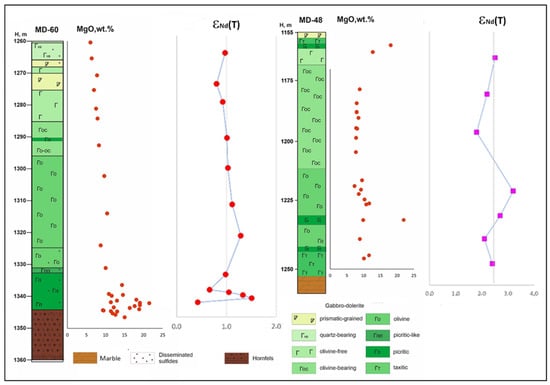
Figure 3.
The MgO and ԐNd(T) variations in the MD-60 and MD-48 boreholes. Nd isotopic data for MD-60 are from this work (Table 1) and from [22,23] for MD-48.
The main volume of the intrusion consists of olivine and olivine-bearing rocks overlapping picritic gabbro-dolerites. They have a poikilophitic structure, occurred as large clinopyroxene oikocrysts (up to 8 mm) containing plagioclase khadacrysts elongated to 1 mm. The compositions of rock-forming minerals correlate with the whole-rock compositions, so that the most magnesian olivine Fo79.8 (Figure 4), clinopyroxene Mg# 72.6, and the most basic plagioclase An78.1 were found in the horizon composed of the picritic gabbro-dolerites (Table S1).
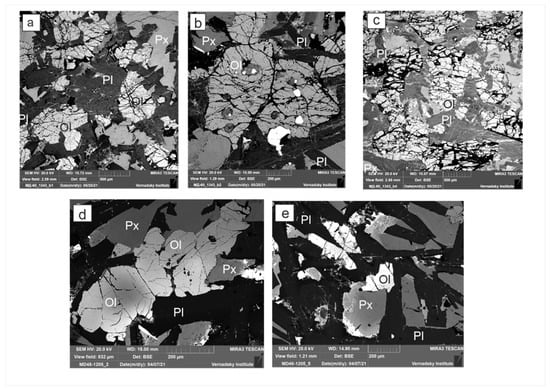
Figure 4.
Back-scattered electron images of the rocks in MD-60 (a–c) and MD-48 (d,e). Subidiomorphic olivine zoned grains: (a) large olivine grains among plagioclases; (b) large olivine grains with melt and spinel inclusions; (c) large olivine grains in a pyroxene-plagioclase matrix; (d) zoned olivine grains, e-small elongated olivine grains and intergrows of olivine with pyroxene. Pl—plagioclase, Ol—olivine, Px—clinipyroxene.
4.1.2. Intrusion in the MD-48 Borehole
The intrusion penetrated by the M-48 borehole at a depth of 1157–1257 m (Figure 2 and Figure 3) was named Mikchangdinsky [24]. The following gabbro-dolerite varieties were distinguished in the vertical section of the intrusion (from bottom to top): olivine, taxitic, picritic, olivine-bearing, olivine-free, upper picritic, upper taxitic, and prismatic-granular (Figure 3). Thus, the rock succession in the MD-48 borehole differs from the MD-60 sequence due to the presence of high-Mg rocks in the upper part of the intrusion, represented by upper picritic and upper taxitic horizons. This structure is similar to low sulfide mineralization massifs [25]. The taxitic texture characterizes the sub-contact horizons (the upper one is at a depth of 1155–1160 m and the lower one is at a depth of 1247–1257 m), whereas the poikilophitic texture is typical of the inner part of the intrusion, similar to rocks in the MD-60 borehole.
Olivine forms both idiomorphic and irregularly shaped crystals up to 1.5 mm tending to the periphery of augite oikocrysts. Its amount and composition vary from olivine-bearing gabbro-dolerites to picritic gabbro-dolerite containing from 3 to 65 vol.%, and from Fo56.8 to Fo80.7, correspondingly. Contrasting zoned olivine grains were found in these rocks (Figure 4 and Figure 5), contrary to those in MD-60 [24]. Their composition was determined using a specially developed method [26], which allows for increasing the detection limit of impurities in olivine (Ti, Ca, Mn, Co, Ni) to 10 ppm. The accuracy of determination of the forsterite molar fraction in olivine was 0.2% (Table S1). The results of measurements of the most contrasting zoned grains are shown in Figure 5 and given in Table S1 (highlighted in bold) and in (Krivolutskaya et al., 2009 [24]), where the range of Fo contents is 20.1 mol.%.
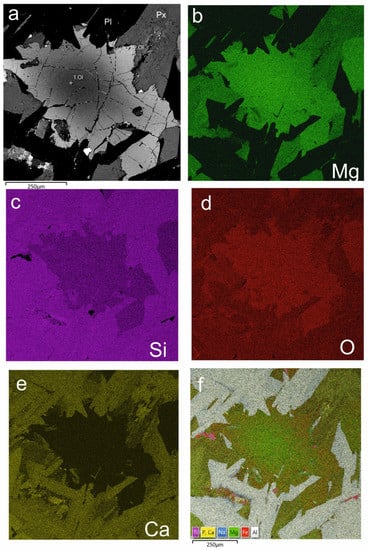
Figure 5.
Zoned olivine (sample MD-48/1205). (a) back-scattered electron image, (b–f) images in characteristic X-Ray: (b) Mg KL; (c) Si KL; (d) -O KL; (e) Ca KL; (f) multi elements (Tescan Mira 3).
Plagioclase in the rocks is the earliest liquidus phase, demonstrating cotectic crystallization with olivine. Plagioclase composition varies dramatically, similar to olivine: An78-80 occurs in the picritic gabbro-dolerites whereas An37 dominates in olivine-bearing gabbro-dolerites. One grain’s difference between the center and the periphery can reach 30 mol.% (Table S1, Nos. 60 and 61). Contrast zonation is also typical for pyroxenes, in which the marginal parts of the grains differ from the central ones in mg# 16 (Table S1, No. 105, 106). Orthopyroxene (up to 2 vol.%, mg# = 76–77) mostly forms tiny rims around olivine.
There are also small grains of magnetite, ilmenite, apatite, and sulfides (up to 5% in total). Taxitic gabbro-dolerites are characterized by intensive alteration of olivine and pyroxenes resulting in the occurrence of secondary minerals (serpentine, amphibole) coupled with the presence of veinlets and inclusions of sulfide minerals (up to 5 vol.%).
Thus, the main mineralogical difference between the intrusive bodies in the MD-48 and MD-60 boreholes is the presence of contrasting zoned rock-forming minerals, especially olivine, indicating more rapid crystallization of parental magma in the first intrusion. These different rates of magmas’ cooling provide evidence of their different P-T conditions of crystallization and these two rocks probably could not be produced from one magma portion. We suggest that two separated intrusions were penetrated by the MD-48 and MD-60 boreholes.
4.2. Geochemical Characteristics of the Intrusions at the Mikchangda Area
4.2.1. Major and Trace Elements in the Rocks
The different inner structure of the intrusive bodies in MD-60 and MD-48 boreholes is also manifested by variations of major oxides (Figure S1a,b) in the rocks through their vertical sections, for example, MgO (Figure 3, Table S3). High concentrations of this oxide are characteristic of the lower parts of the intrusive bodies and the upper zone of the MD-48 intrusion, where picritic gabbro-dolerites are common. The central zones of both intrusions have close and sufficiently stable MgO content (around 10 wt.%), which decreases towards the roof of the MD-60 intrusion and increases in the MD-48 intrusion. Figure S1a in Supplementary Materials (MD-60) and Figure S1b (MD-48) show the distribution of the other oxides in the boreholes.
The non-uniform distribution of some oxides (Al2O3, TiO2, and CaO) characterizes the picritic gabbro-dolerites in the MD-60 borehole. At the same time, the Fe2O3, Ni, and Cu contents are maximal in their central parts due to an accumulation of sulfides. The upper part of this intrusion comprises elevated TiO2, CaO, Na2O, and K2O, as well as Cu. The latter reflects sulfide appearance (1–2 vol.%) in the rocks. The maximum metal concentrations in the picritic gabbro-dolerites reach (wt.%): Cu 0.9, Ni 0.5, Co 0.02, Cr2O3 0.27, Pd 3.4 ppm, Pt 0.9 ppm (Table S3). These contents, including As, Se, Te, and Sb, are similar to those observed in the Kharaelakh, Talnakh, and Norilsk 1 deposits. In general, the concentrations of these semimetals are low (Table S3) and are often below the detection limit.
The intrusion in the MD-48 borehole has two horizons where high metal concentrations were detected (Figure S1b), i.e., lower picritic and taxitic gabbro-dolerites and upper picritic and taxitic gabbro-dolerites. However, the Cu, Ni, and Co concentrations are lower than those in MD-60 borehole, where they are 0.3, 0.2, and 0.01 wt.%, respectively.
Comparison of rock compositions from two boreholes in the Harker diagrams (Figure 6) indicates the proximity of their compositions. Thus, the ranges of MgO variations in both intrusions are similar (wt.%): 7.14–24.56 in MD-48 and 6.04–21.48 in MD-60 (Figure 6a–h), as well as the TiO2 (0.6–1.3), SiO2 (39.6–50.0), and Na2O (0.8–2.3) ranges. Rocks from MD-60 are enriched in (wt.%): CaO (up to 18.6), K2O (3), and P2O5 (0.25), and depleted in Fe2O3 (5.3). Elevated alkalis are typical of the endocontact zones of intrusions.
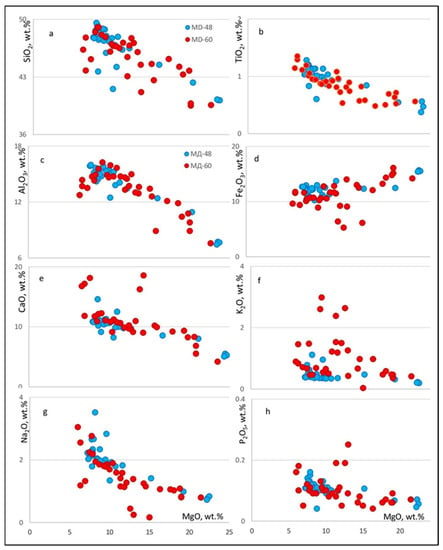
Figure 6.
Variation diagrams MgO vs. SiO2 (a), TiO2 (b), CaO (c), Na2O (d), K2O (e), P2O5 (f) for the rocks from the (g) MD-48 MgO and (h) MD-60 MgO boreholes.
The patterns of trace elements in the rocks from two studied intrusions (Figure 7) are characterized by features typical of the Siberian traps, i.e., distinct Ta-Nd negative and U, Pb, and Sr positive anomalies occur [27]. The pattern of all spectra is very similar (Figure 7). However, a more detailed examination of the element ratios reveals certain differences between the examined rocks.
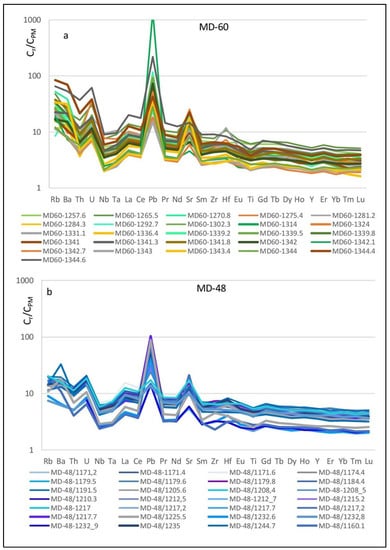
Figure 7.
Spider-diagrams for rocks from the MD-60 (a) and MD-48 (b) borehole (normalized to PM after Hofmann, 1988).
The rocks in the MD-48 borehole are characterized by sustained (Th/U)n, (U/Nb)n, (La/Sm)n, and (Gd/Yb)n ratios, whereas larger variations of these elements are typical of the rocks in the MD-60 borehole (Figure S2). To some extent these variations could occur due to the contamination of magma by host rocks, especially in the contact zones. This suggestion is confirmed by the composition of the surrounding rocks of the MD-60 intrusion which is shown by a green diamond in Figure S2.
4.2.2. Results of the Rb-Sr and Sm-Nd Isotopic Studies
Table 1 demonstrates the Rb-Sr and Sm-Nd isotopic data on gabbro-dolerites penetrated by the MD-60 borehole in the Mikchangda area. The initial Sr and Nd isotopic ratios are calculated for the age of 250 million years.
These data show that the initial isotopic ratios of Nd in the studied samples are quite stable (Figure 3), the average value is ԐNd(T) = +1.0 ± 0.6 (2σ), the greatest variations are observed only near the lower contact of the intrusion.


Table 1.
Results of Rb-Sr and Sm-Nd isotopic systems analysis of the gabbro-dolerites (MD-60).
Table 1.
Results of Rb-Sr and Sm-Nd isotopic systems analysis of the gabbro-dolerites (MD-60).
| Sample | Rb, ppm | Sr, ppm | 87Rb/86Sr | 87Sr/86Sr±2σ | (87Sr/86Sr)0 | Sm, ppm | Nd, ppm | 147Sm/144Nd | 143Nd/144Nd ± 2σ | ԐNd(T) |
|---|---|---|---|---|---|---|---|---|---|---|
| MD-60/1265.5 | 30.5 | 437 | 0.202 | 0.707976 ± 7 | 0.70727 | 3.57 | 13.10 | 0.1649 | 0.512636 ± 3 | 0.97 |
| MD-60/1275.4 | 16.35 | 564 | 0.0839 | 0.708169 ± 9 | 0.70788 | 2.90 | 10.85 | 0.1615 | 0.512621 ± 7 | 0.80 |
| MD-60/1281.2 | 14.27 | 304 | 0.1356 | 0.707026 ± 7 | 0.70655 | 2.71 | 9.69 | 0.1688 | 0.512640 ± 5 | 0.93 |
| MD-60/1292.7 | 10.68 | 249 | 0.1241 | 0.706555 ± 4 | 0.70612 | 2.26 | 8.16 | 0.1670 | 0.512641 ± 6 | 1.01 |
| MD-60/1302.3 | 11.72 | 234 | 0.1447 | 0.706685 ± 9 | 0.70618 | 2.02 | 7.22 | 0.1690 | 0.512645 ± 4 | 1.03 |
| MD-60/1314 | 10.11 | 286 | 0.1022 | 0.707116 ± 5 | 0.70676 | 1.885 | 6.77 | 0.1683 | 0.512649 ± 9 | 1.11 |
| MD-60/1324 | 15.72 | 260 | 0.1747 | 0.706893 ± 6 | 0.70628 | 2.12 | 7.69 | 0.1670 | 0.512655 ± 9 | 1.29 |
| MD-60/1336.4 | 12.22 | 253 | 0.1397 | 0.707202 ± 5 | 0.70671 | 1.581 | 5.91 | 0.1618 | 0.512631 ± 5 | 0.98 |
| MD-60/1341.3 | 21.9 | 330 | 0.1921 | 0.708122 ± 8 | 0.70745 | 2.28 | 8.61 | 0.1603 | 0.512612 ± 8 | 0.66 |
| MD-60/1342.1 | 12.70 | 98.5 | 0.373 | 0.708591 ± 6 | 0.70729 | 1.257 | 4.52 | 0.1681 | 0.512645 ± 14 | 1.05 |
| MD-60/1343 | 7.87 | 181.2 | 0.1257 | 0.706592 ± 16 | 0.70615 | 1.168 | 4.10 | 0.1720 | 0.512666 ± 7 | 1.33 |
| MD-60/1344 | 7.89 | 169.8 | 0.1344 | 0.706674 ± 11 | 0.70620 | 1.209 | 4.28 | 0.1709 | 0.512673 ± 14 | 1.51 |
| MD-60/1345.3 | 62.1 | 222 | 0.809 | 0.712051 ± 16 | 0.70922 | 3.75 | 13.81 | 0.1640 | 0.512606 ± 5 | 0.42 |
Note. The sample number is borehole number/depth, m. The errors near isotopic ratios correspond to the last significant digits of the ratio.
5. Discussion
Isotopic studies of intrusive rocks of the Norilsk region in order to understand their genesis and find criteria of their economic value have been conducted for three decades [23,25,27,28,29,30,31,32,33,34].
Parental magma composition is one of the major factors in the origin of the Cu-Ni-PGE deposits. Some researchers believe that magma composition (including volatile components) plays the leading role in ore genesis [4,7,35,36], whereas others suggest crustal assimilation to be responsible for the sulfide formation [13,37,38]. The answer to this question largely determines the understanding of the genesis of ore deposits and the success of further prospecting within the Siberian igneous province.
Our geochemical studies of intrusions in the eastern part of the Norilsk region indicate the extreme proximity of their composition in terms of major and trace elements, as noted earlier [39]. However, their isotopic characteristics provide evidence of marked differences in the distribution of the Sr and Nd isotopic ratios between ore-bearing and barren intrusions on the one hand, and volcanic rocks on the other hand. Many researchers have previously noted that ore-bearing rocks are characterized by narrower variations in the Nd isotopic ratio than barren [25,29,35,40], even if it was not shown based on statistically representative samples. For the first time we provide a generalization of all available isotopic data on igneous rocks from the Norilsk region, including both those published earlier and our recent results. These data allowed us to demonstrate systematic isotopic and geochemical differences between ore-bearing intrusive bodies, barren intrusions, and basalts. In futher discussion we consider the rocks of the extra-large deposits (Talnakh, Kharaelakh, Norilsk-1, and Maslovsky), as well as six intrusive bodies with smaller deposits (Chernogorsky, Vologochansky, South-Pyasinsky, Zubovsky, Imangdinsky, and Norilsk-2), which could be of interest to mining companies if there were no giant deposits nearby as ore-bearing intrusions. All these intrusions belong to the Norilsk intrusive complex [16].
The initial isotopic ratio of Nd (T = 250 million years) in the samples of all ten intrusions is within narrow limits (Figure 8) ԐNd(T) = 1.0 ± 1.0. In barren, weekly mineralized and volcanic rocks, the variations in the isotopic ratio of Nd are incomparably wider. The differences in the variations in the Nd isotopic ratios are clearly visible on the summary histogram (Figure 9). The variations in the Sr isotopic composition are also noticeably different (Figure 10). Despite the range of the (87Sr/86Sr)0, values in ore-bearing rocks are as wide as in barren rocks, the peak of isotopic ratio is about 0.7060 ± 4.
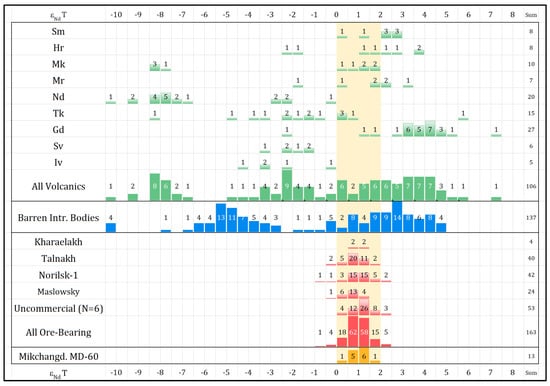
Figure 8.
Histogram of the Nd isotopic composition (ԐNdT) in volcanic and intrusive rocks in the Norilsk region [23,25,27,28,29,30,31,32,33,34,41,42,43,44,45]. Note that the isotopic data for samples from the MD-60 borehole (this work) exactly correspond to the ore-bearing rocks. Volcanic Formations: Sm—Samoedsky, Hr—Haraelakhsky, Mk—Mokulaevsky, Mr—Morongovsky, Nd—Nadezhdinsky, Tk—Tuklonsky, Gd—Gudchikhinsky, Sv—Siverminsky, Iv—Ivakinsky.
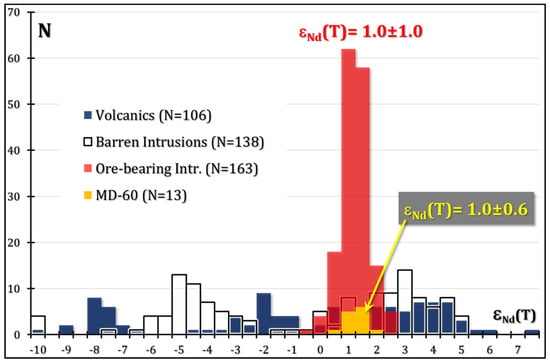
Figure 9.
Summarized histograms of the ԐNd(T) values in magmatic rocks of the Norilsk region. Data sources are shown at the Figure 8.
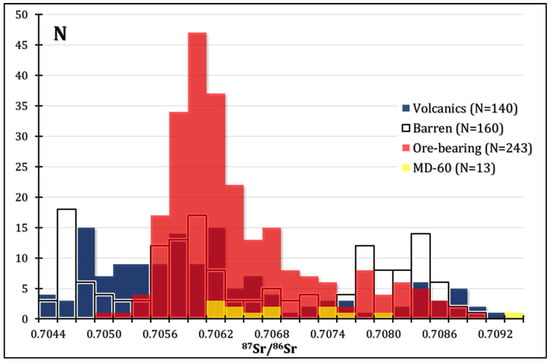
Figure 10.
Histograms of the initial 87Sr/86Sr in magmatic rocks of the Norilsk region. Data sources are shown at the Figure 8.
Systematic differences in the distribution of the Nd isotope ratio in ore–bearing and barren intrusions can be used as a local isotope criterion of intrusions with Cu-Ni-PGE sulfide mineralization in the Norilsk ore region.
The genetic relationships between the sources of volcanic rocks and ore-bearing intrusions are not obvious. No one volcanic formation completely coincides with ore-bearing intrusive rocks with respect to the age-corrected Nd isotopic composition (Figure 8). However, the Nd and Sr isotopic compositions of the ore-bearing rocks only display a compact cluster inside of variations of these isotopic ratios in barren rocks and volcanics. Therefore, it cannot be excluded that the source of all the parent melts was common, however, we suggest that in the course of their evolution, only magmas parental to ore-bearing intrusions became much more isotopically homogeneous than those for barren ones.
The Ni vs. Pt contents (Figure 11A) as well as Pt and Pd (Figure 11B) form wide ranges (four orders for Pt and Pd and three orders for Ni) and steadily correlate in ore-bearing and barren intrusive rocks, unlike volcanics. However, the concentration of these elements is unlikely to be due to fractionation of silicate minerals, because it is not accompanied by an increase in the La/Lu ratio (Figure 12). On the contrary, in the ore-bearing rocks, the La/Lu ratio is consistently low and remains stable even in a high range of Ni and MgO variations in the rocks. Similar relationships are observed between the Nd isotopic composition and Ni contents (Figure 13). A change in Ni and PGE content within three and four orders of magnitude (compare Figure 11 and Figure 13) in ore-bearing rocks does not accompany variations in Nd isotopic composition. Consequently, the accumulation of metals was not related to the contamination of parental magmas by any external (crustal?) material.
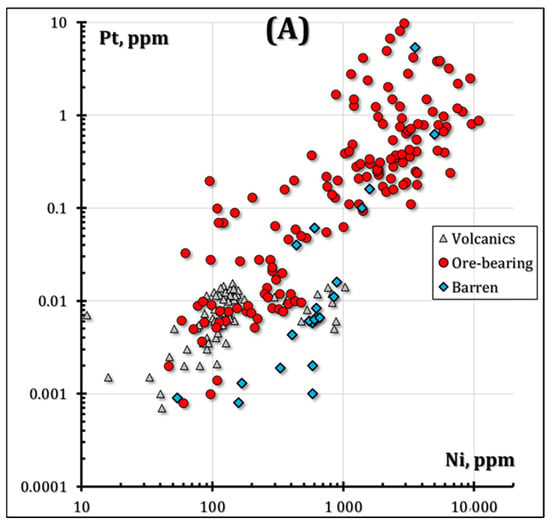
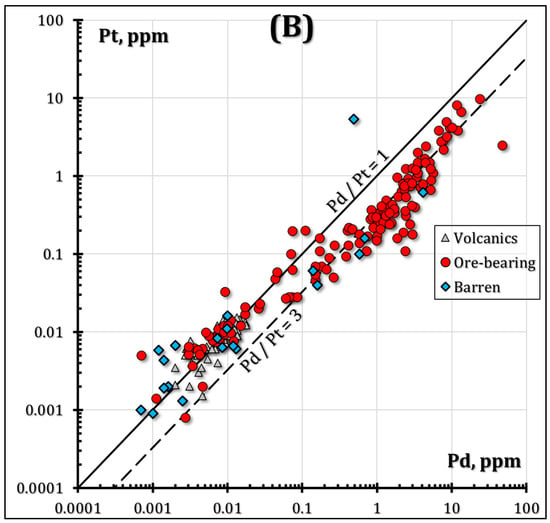
Figure 11.
Ni and Pt (A) as well as Pt and Pd (B) contents correlate in ore-bearing and barren intrusive rocks. There are no such correlations in volcanics; however, their datapoints coincide with the trend of the intrusive rocks in the low contents part. Data from [27,28,29,33,34,46]. Note the increase in the Pd/Pt ratio as their concentrations in the rocks increase.
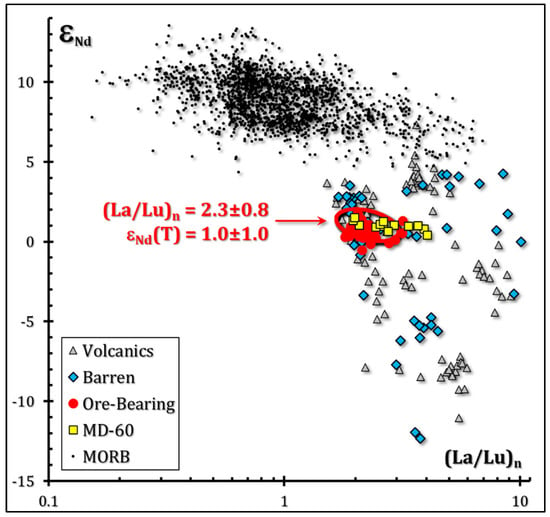
Figure 12.
Chondrite-normalized La/Lu ratio and εNd(T) variations in the magmatic rocks of the Norilsk region in comparison with MORB data [47,48]. Two-sigma ellipse for data from ore-bearing intrusions is shown with a red line. Values for ore-bearing rocks are much more compact than those for barren intrusions and volcanic rocks.
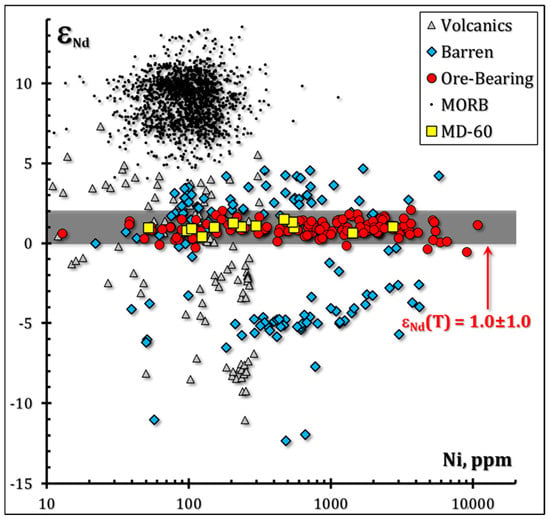
Figure 13.
ԐNd(T) and Ni contents in volcanics, ore-bearing, and barren intrusive rocks. Note the absence of correlation between eNd(T) and Ni, suggesting that metal enrichment was not related to anomalous material assimilation by parent magmas. Compositions of the samples from MD-60 borehole on this plot are in good agreement with ore-bearing data.
A common inverse correlation between Nd and Sr isotopic ratios is observed in barren intrusive and volcanic rocks only, whereas it is absent in the ore-bearing intrusive bodies (Figure 14) mostly due to a very narrow range of the Nd isotopic ratio variations in the ore-bearing rocks.
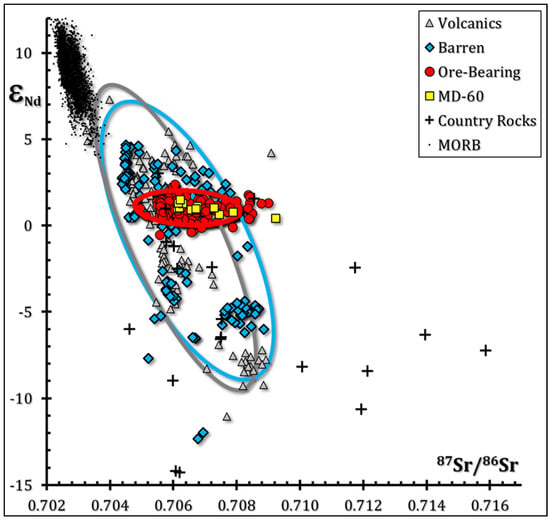
Figure 14.
Initial Sr isotopic ratio and ԐNd(T) variations in the magmatic rocks of the Norilsk region in comparison with MORB data [47,48] and the Norilsk area deep-seated basement country (sedimentary, granitic and metamorphic) rocks [28,30]. Two-sigma ellipses are shown for volcanic rocks (grey line), barren intrusive rocks (blue line), and ore-bearing intrusive rocks (red line) to present scatters of every type of data. Note the position of most of the Mikchangda rocks’ data (MD-60) inside the ore-bearing rocks ellipse.
The combination of the Nd isotopic data and the La/Lu ratio on a single graph (Figure 12) gives the most striking differences between ore-bearing and barren intrusions. The former form a very compact cluster, whereas the latter show a wide range of these parameters similar to volcanics. The ellipse shown in Figure 12 can be used as the most reliable signature of potentially economic Cu-Ni-PGE deposits in this part of the Siberian province.
The gabbro-dolerite intrusion at the Mikchangda area discovered by the MD-60 borehole does not differ in all geochemical parameters from the rocks of ore-bearing massifs (Figure 8, Figure 9, Figure 10, Figure 11, Figure 12, Figure 13 and Figure 14). They have the same compact isotopic composition of Nd, only slightly wider variations of the La/Lu ratio and the Sr isotopic composition (Figure 14). These data indicate that the rocks uncovered by the MD-60 borehole may be of practical interest to mining companies. Statistical analysis confirms obvious similarity of Nd isotopic ratio distributions in the ore-bearing rocks and rocks from the borehole MD-60, The P-value of the K-S test is as high as 0.78. Such correspondence is not observed for the Sr isotopic ratio, in this case P-value is just 0.03. We have to admit that we do not fully understand such a contrast in the behavior of the two isotopic systems.
6. Conclusions
1. For the first time the authors studied two new intrusions at the Mikchangda area, i.e., in the MD-48 and MD-60 boreholes, with unknown economic value. They are similar in geological setting, morphology, thickness, and major oxides contents in the rocks. However, they are different in textural and structural features, that indicate more rapid crystallization of the MD-48 intrusion in comparison with MD-60. According to the contents of the major oxides, the rocks in MD-48 and MD-60 are indistinguishable, but they differ in U/Nb, La/Sm, and Gd/Yb ratios.
2. It is found that the rocks in the MD-60 borehole are characterized by ԐNd(T) = 1.0 ± 0.6 and fall into the range of ore-bearing intrusions, whereas the rocks in MD-48 have ԐNd(T) 2.4 ± 0.9, and, thus, are outside of the characteristics of the economic deposits. Therefore, ԐNd(T) values can be used as a local criterion for the estimation of economic potential of mafic intrusions, which is demonstrated for the Mikchangda area.
Supplementary Materials
The following supporting information can be downloaded at: https://www.mdpi.com/article/10.3390/min13020213/s1, Table S1. Composition of rock-forming minerals from rocks in the MD-60 and MD-48 boreholes; Table S2. Composition of sulfides; Table S3. Compositions of rocks in boreholes MD-48 and MD-60 (major and trace elements; Figures S1a,b. Distribution of major oxides in the MD-60 and MD-48 boreholes; Figure S2. Diagrams (Th/U)n-(U/Nb)n and (Gd/Yb)n-(La/Sm)n for the rocks from the MD-60 and MD-48 boreholes.
Author Contributions
Conceptualization, writing, Y.K. and N.K.; formal analysis, M.A., A.V.S. and S.D.; investigation, A.K. All authors have read and agreed to the published version of the manuscript.
Funding
This research was financially supported by the Ministry of Science and Higher Education of the Russian Federation No. 13.1902.21.0018 (agreement 075-15-2020-802).
Data Availability Statement
The used data are obtained from following publications: [25,27,28,29,30,31,32,33,34,41,42,43,44,45,46,47,48].
Acknowledgments
We are grateful geologists of LLT. Norilskgeolgy V.N. Mikhailov, K.V. Shishaev, V.Y. Van-Chan, L.I. Trofimova, I.N. Tushentsova for assistance in the borehole sampling.
Conflicts of Interest
The authors declare no conflict of interest.
References
- Urvantsev, N.N. North-Siberian nickel province. In North-Siberian Ni Region and Its Economic Perspectives (In Russian); NIIGA: Leningrad, Russia, 1973; pp. 5–15. [Google Scholar]
- Kamo, S.L.; Czamanske, G.K.; Amelin, Y.; Fedorenko, V.A.; Davis, D.; Trofimov, V. Rapid eruption of Siberian flood-volcanic rocks and evidence for coincidence with the Permian–Triassic boundary and mass extinction at 251 Ma. Earth Planet. Sci. Lett. 2003, 214, 75–91. [Google Scholar] [CrossRef]
- Malitch, K.N.; Belousova, E.A.; Griffin, W.L.; Badanina, I.Y.; Latypov, R.M.; Sluzhenikin, S.F. New insights on the origin of ultramafic-mafic intrusions and associated Ni-Cu-PGE sulfide deposits of the Noril’sk and Taimyr provinces, Russia: Evidence from radiogenic-and stable-isotope data. In Processes and Ore Deposits of Ultramafic-Mafic Magmas through Space and Time; Elsevier: Amsterdam, The Netherlands, 2018; pp. 197–238. [Google Scholar]
- Godlevsky, M. Traps and Ore-Bearing Intrusions of the Noril’sk Region; Gosgeoltekhizdat: Moscow, Russia, 1959; Volume 89. [Google Scholar]
- Likhachev, A. Platinum-Copper-Nickel and Platinum Deposits; Eslan: Moscow, Russia, 2006; Volume 496. [Google Scholar]
- Duzhikov, O.; Distler, V.; Rylkova, G.; Naldrett, A.J. Geology and Metallogeny of Sulfide Deposits Noril’sk Region USSR; Society of Economic Geologists: Littleton, CO, USA, 1992. [Google Scholar]
- Distler, V.; Sluzhenikin, S.; Krivolutskaya, N.; Turovtsev, D.; Golovanova, T.; Mokhov, A.; Cabri, L.; Knauf, V.; Oleshkevich, O. Platinum ores of the Noril’sk layered intrusions: Magmatic and fluid concentration of noble metals. Geol. Ore Depos. 1999, 41, 214–237. [Google Scholar]
- Naldrett, A.J. A model for the Ni-Cu-PGE ores of the Noril’sk region and its application to other areas of flood basalt. Econ. Geol. 1992, 87, 1945–1962. [Google Scholar] [CrossRef]
- Naldrett, A.J. Fundamentals of magmatic sulfide deposits. In Magmatic Ni-Cu and PGE Deposits: Geology, Geochemistry, and Genesis; GeoScienceWorld: McLean, VA, USA, 2011. [Google Scholar]
- Likhachev, A.P. Ore-bearing intrusions of the Noril’sk region. In Proceedings of the Sudbury Noril’sk Symposium, Sudbury, ON, Canada, 3–6 October 1992; Ontario Ministry of Northern Development and Mines: Sudbury, ON, Canada, 1994; pp. 185–202. [Google Scholar]
- Rad’ko, V.A. Model of dynamic differentiation of intrusive traps in the northwestern Siberian platform. Sov. Geol. Geophys. 1991, 32, 70–77. [Google Scholar]
- Naldrett, A.J.; Fedorenko, V.; Lightfoot, P.C.; Kunilov, V.E.; Gorbachev, N.S.; Doherty, W.; Johan, J. Ni-Cu-PGE deposits of Noril’sk region, Siberia: Their formation in conduits for flood basalt volcanism. Trans. Inst. Min. Metallurgy. Sect. B Appl. Earth Sci. 1995, 104, 18–36. [Google Scholar]
- Li, C.; Ripley, E.M.; Naldrett, A.J. A new genetic model for the giant Ni-Cu-PGE sulfide deposits associated with the Siberian flood basalts. Econ. Geol. 2009, 104, 291–301. [Google Scholar] [CrossRef]
- Li, C.; Ripley, E.M.; Naldrett, A.J.; Schmitt, A.K.; Moore, C.H. Magmatic anhydrite-sulfide assemblages in the plumbing system of the Siberian Traps. Geology 2009, 37, 259–262. [Google Scholar] [CrossRef]
- Krivolutskaya, N.A.; Gongalsky, B.I.; Kedrovskaya, T.B.; Kubrakova, I.V.; Tyutyunnik, O.A.; Chikatueva, V.Y.; Bychkova, Y.V.; Magazina, L.O.; Kovalchuk, E.N.; Yakushev, A.I. Geology of the western flanks of the Oktyabr’skoe deposit, Noril’sk district, Russia: Evidence of a closed magmatic system. Miner. Depos. 2019, 54, 611–630. [Google Scholar] [CrossRef]
- Lul’ko, V. The Legend for 1:50,000 Scale Map, Noril’sk Group; Mosc. Geoinformmark: Moscow, Russia, 1993; 139p. [Google Scholar]
- Karandashev, V.K.; Khvostikov, V.A.; Nosenko, S.V.; Burmii, Z.P. Stable highly enriched isotopes in routine analysis of rocks, soils, grounds, and sediments by ICP-MS. Inorg. Mater. 2017, 53, 1432–1441. [Google Scholar] [CrossRef]
- Seregina, I.F.; Ognev, V.E.; Sedykh, E.M.; Kolotov, V.P.; Krivolutskaya, N.A.; Bolshov, M.A. Determination of chalcophile elements in sulfide-bearing rocks by hydride generation inductively coupled plasma optical emission spectrometry and inductively coupled plasma mass spectrometry. Spectrochim. Acta Part B At. Spectrosc. 2020, 166, 105790. [Google Scholar] [CrossRef]
- Kostitsyn, Y.A.; Zhuravlev, A.Z. Analysis of Errors and Optimization of Method of Isotope Dilution; Geokhimia: Moscow, Russia, 1987; pp. 1024–1036. [Google Scholar]
- Revyako, N.M.; Kostitsyn, Y.A.; Bychkova, Y.V. Interaction between a mafic melt and host rocks during formation of the Kivakka layered intrusion, North Karelia. Petrology 2012, 20, 101–119. [Google Scholar] [CrossRef]
- Villa, I.M.; De Bièvre, P.; Holden, N.; Renne, P. IUPAC-IUGS recommendation on the half life of 87Rb. Geochim. Cosmochim. Acta 2015, 164, 382–385. [Google Scholar] [CrossRef]
- Malitch, K.N.; Badanina, I.Y.; Tuganova, E.V. Magmatic evolution of the ultramafic–mafic intrusions of the Noril’sk Province (Russia): Insights from compositional and geochronological data. Lithosphera 2010, 10, 37–63. [Google Scholar]
- Oleg, P. (Ed.) Isotope Geology of the Norilsk Deposits; Springer: Berlin/Heidelberg, Germany, 2019. [Google Scholar]
- Krivolutskaya, N.A.; Sobolev, A.V.; Kuzmin, D.V.; Svirskaya, N.M. Unique zoned olivines from an ultrabasic—Basic massif in the Noril’sk disitrict. In Doklady Earth Sciences; Springer Nature: Berlin/Heidelberg, Germany, 2009; p. 1496. [Google Scholar]
- Sluzhenikin, S.F.; Yudovskaya, M.A.; Barnes, S.J.; Abramova, V.D.; Le Vaillant, M.; Petrenko, D.B.; Grigor’eva, A.V.; Brovchenko, V.D. Low-sulfide platinum group element ores of the Norilsk-Talnakh camp. Econ. Geol. 2020, 115, 1267–1303. [Google Scholar] [CrossRef]
- Sobolev, A.V.; Hofmann, A.W.; Kuzmin, D.V.; Yaxley, G.M.; Arndt, N.T.; Chung, S.-L.; Danyushevsky, L.V.; Elliott, T.; Frey, F.A.; Garcia, M.O.; et al. The Amount of Recycled Crust in Sources of Mantle-Derived Melts. Science 2007, 316, 412–417. [Google Scholar] [CrossRef] [PubMed]
- Wooden, J.L.; Czamanske, G.K.; Fedorenko, V.A.; Arndt, N.T.; Chauvel, C.; Bouse, R.M.; King, B.S.W.; Knight, R.J.; Siems, D.F. Isotopic and Trace-Element Constraints on Mantle and Crustal Contributions to Siberian Continental Flood Basalts, Norilsk Area, Siberia. Geochim. Cosmochim. Acta 1993, 57, 3677–3704. [Google Scholar] [CrossRef]
- Hawkesworth, C.J.; Lightfoot, P.C.; Fedorenko, V.A.; Blake, S.; Naldrett, A.J.; Doherty, W.; Gorbachev, N.S. Magma Differentiation and Mineralization in the Siberian Continental Flood Basalts. Lithos 1995, 34, 61–88. [Google Scholar] [CrossRef]
- Arndt, N.T.; Czamanske, G.K.; Walker, R.J.; Chauvel, C.; Fedorenko, V.A. Geochemistry and origin of the intrusive hosts of the Noril’sk-Talnakh Cu-Ni-PGE sulfide deposits. Econ. Geol. 2003, 98, 495–515. [Google Scholar] [CrossRef]
- Czamanske, G.K.; Wooden, J.L.; Walker, R.J.; Fedorenko, V.A.; Simonov, O.N.; Budahn, J.R.; Siems, D.F. Geochemical, Isotopic, and SHRIMP Age Data for Precambrian Basement Rocks, Permian Volcanic Rocks, and Sedimentary Host Rocks to the Ore-bearing Intrusions, Noril’sk-Talnakh District, Siberian Russia. Int. Geol. Rev. 2000, 42, 895–927. [Google Scholar] [CrossRef]
- Krivolutskaya, N.A.; Sobolev, A.V.; Mikhailov, V.N.; Plechova, A.A.; Kostitsyn, Y.A.; Roschina, I.A.; Fekiacova, Z. Parental melt of the Nadezhdinsky Formation: Geochemistry, petrology and connection with Cu-Ni deposits (Noril’sk area, Russia). Chem. Geol. 2012, 302–303, 87–105. [Google Scholar] [CrossRef]
- Lightfoot, P.C.; Naldrett, A.J.; Gorbachev, N.S.; Doherty, W.; Fedorenko, V.A. Geochemistry of the Siberian Trap of the Noril’sk area, USSR, with implications for the relative contributions of crust and mantle to flood basalt magmatism. Contrib. Mineral. Petrol. 1990, 104, 631–644. [Google Scholar] [CrossRef]
- Lightfoot, P.C.; Hawkesworth, C.J.; Hergt, J.; Naldrett, A.J.; Gorbachev, N.S.; Fedorenko, V.A.; Doherty, W. Remobilization of the Continental Lithosphere by a Mantle Plume-Major-Element, Trace-Element, and Sr- Isotope, Nd-Isotope, and Pb-Isotope Evidence from Picritic and Tholeiitic Lavas of the Norilsk District, Siberian Trap, Russia. Contrib. Mineral. Petrol. 1993, 114, 171–188. [Google Scholar] [CrossRef]
- Malitch, K.N.; Badanina, I.Y.; Tuganova, E.V. Ore-Bearing Ultramafic-Mafic Intrusions of Polar Siberia: New Insights on the Age, Origin and Prediction Criteria (In Russian); Koroteyev, V.A., Ed.; Institute of Geology and Geochemistry: Ekaterinburg, Russia, 2018; p. 287. [Google Scholar]
- Aplonov, V.S. Fluid Regime and Platimun Potencial Problems of Basic Differentiated Intrusions; Platimun of Russia. M. Geoinformmark: Moscow, Russia, 1995; pp. 102–106. (In Russian) [Google Scholar]
- Yao, Z.-S.; Mungall, J.E. Linking the Siberian Flood Basalts and Giant Ni-Cu-PGE Sulfide Deposits at Norilsk. J. Geophys. Res. Solid Earth 2021, 126, e2020JB020823. [Google Scholar] [CrossRef]
- Naldrett, A.J.; Naldrett, A.L. Magmatic Sulfide Deposits: Geology, Geochemistry and Exploration; Springer Science & Business Media: Berlin/Heidelberg, Germany, 2004. [Google Scholar]
- Rad’ko, V.A. Facies of Intrusive and Volcanic Magmatism in the Noril’sk District; Map-Making Department at VSEGEI: St. Petersburg Russia, 2016; 226p. (In Russian) [Google Scholar]
- Krivolutskaya, N.A.; Makvandi, S.; Gongalsky, B.I.; Kubrakova, I.V.; Svirskaya, N.M. Chemical Characteristics of Ore-Bearing Intrusions and the Origin of PGE–Cu–Ni Mineralization in the Norilsk Area. Minerals 2021, 11, 819. [Google Scholar] [CrossRef]
- Walker, R.J.; Morgan, J.W.; Horan, M.F.; Czamanske, G.K.; Krogstad, E.J.; Fedorenko, V.A.; Kunilov, V.E. Re-Os Isotopic Evidence for an Enriched-Mantle Source for the Norilsk-Type, Ore-Bearing Intrusions, Siberia. Geochim. Et Cosmochim. Acta 1994, 58, 4179–4197. [Google Scholar] [CrossRef]
- Krivolutskaya, N.A. Formation of PGM-Cu-Ni deposits in the process of evolution of flood-basalt magmatism in the Noril’sk region. Geol. Ore Depos. 2011, 53, 309. [Google Scholar] [CrossRef]
- Krivolutskaya, N.A.; Rudakova, A.V. Structure and geochemical characteristics of trap rocks from the Noril’sk Trough, Northwestern Siberian craton. Geochem. Int. 2009, 47, 635–656. [Google Scholar] [CrossRef]
- Brugmann, G.E.; Naldrett, A.J.; Asif, M.; Lightfoot, P.C.; Gorbachev, N.S.; Fedorenko, V.A. Siderophile and chalcophile metals as tracers of the evolution of the Siberian Trap in the Noril’sk region, Russia. Geochim. Et Cosmochim. Acta 1993, 57, 2001–2018. [Google Scholar] [CrossRef]
- Sobolev, A.V.; Krivolutskaya, N.A.; Kuzmin, D.V. Petrology of the parental melts and mantle sources of Siberian trap magmatism. Petrology 2009, 17, 253. [Google Scholar] [CrossRef]
- Kostitsyn, Y.A.; Krivolutskaya, N.A. Vernadsky Institute of Geochemistry and Analytical Chemistry of the Russian Academy of Sciences, 119991 Moscow, Russia. 2022; Unpublished. [Google Scholar]
- Czamanske, G.K. Petrographic and Geochemical Characterization of Ore-Bearing Intrusions of the Noril’sk Type, Siberia; With Discussion of Their Origin, Including Additional Datasets and Core Logs; US Geological Survey: Reston, VA, USA, 2002; pp. 1258–2331.
- Kostitsyn, Y.A. Terrestrial and Chondritic Sm-Nd and Lu-Hf Isotopic Systems: Are They Identical? Petrology 2004, 12, 397–411. [Google Scholar]
- Kostitsyn, Y.A. Relationships between the Chemical and Isotopic (Sr, Nd, Hf, and Pb) Heterogeneity of the Mantle. Geochem. Int. 2007, 45, 1173–1196. [Google Scholar] [CrossRef]
Disclaimer/Publisher’s Note: The statements, opinions and data contained in all publications are solely those of the individual author(s) and contributor(s) and not of MDPI and/or the editor(s). MDPI and/or the editor(s) disclaim responsibility for any injury to people or property resulting from any ideas, methods, instructions or products referred to in the content. |
© 2023 by the authors. Licensee MDPI, Basel, Switzerland. This article is an open access article distributed under the terms and conditions of the Creative Commons Attribution (CC BY) license (https://creativecommons.org/licenses/by/4.0/).